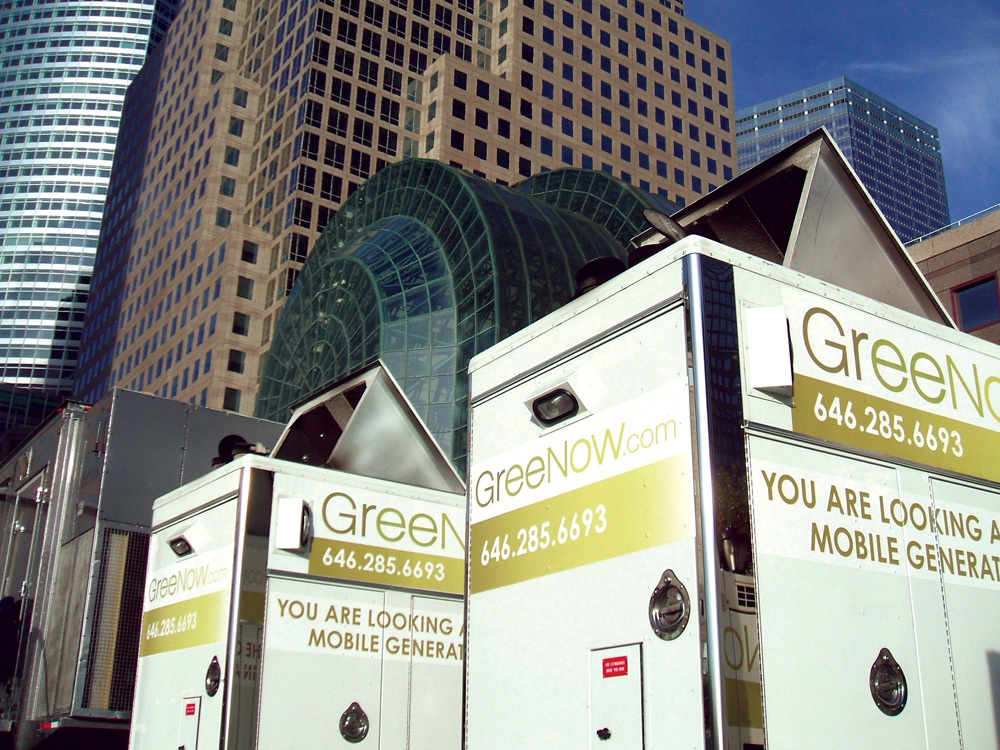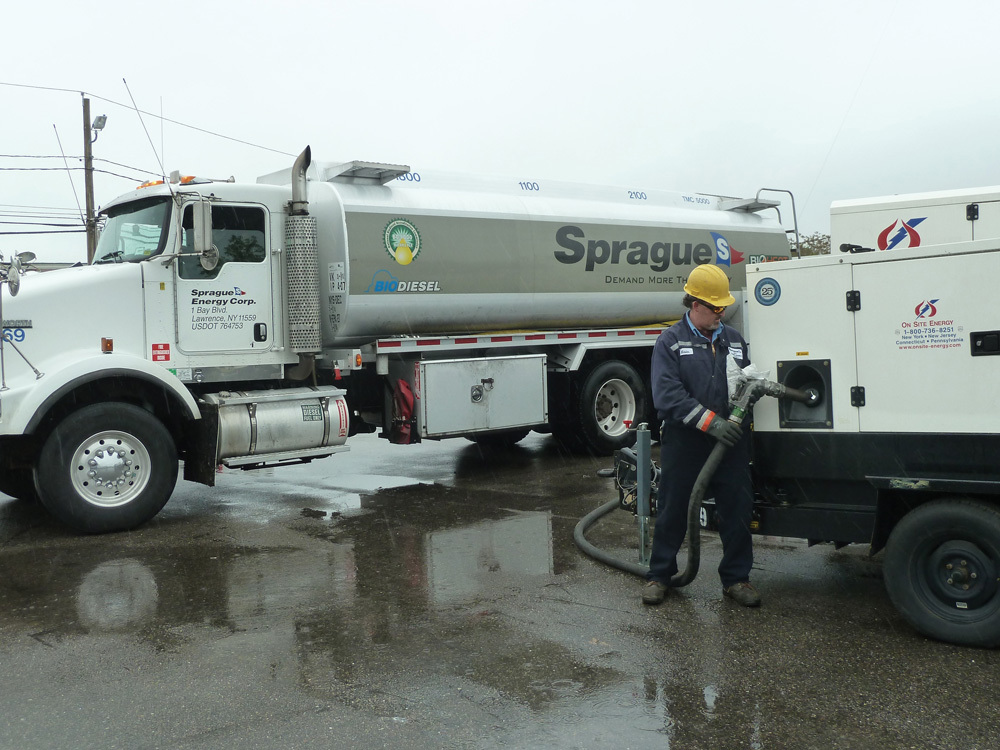Don't Forget the Event



PHOTO: GREENOW
June 14, 2011
BY Luke Geiver
Aaron Levinthal is the first to admit that he didn’t want to be in the generator business. He’s a concert producer at heart; and if companies like Caterpillar or Kohler had listened to him five years ago, he would still be a concert producer. “As a concert producer,” he says, “you hate hearing no, especially when I’d given them a million dollars of business in one year.” Levinthal’s requests were pretty simple: run the generators powering events like the Tribeca Film Festival in New York City or a major concert in Central Park using biodiesel-blended fuel. The obvious reason Levinthal might have pointed to may seem to be the cleaner burning nature of the fuel, or the added lubricity the biodiesel could offer the generators that typically burn 35 gallons of fuel per hour, but for Levinthal, it wasn’t.
“No one had requested it when I started using it,” he explains. “For lack of a better term, I had an epiphany one day that I’m in the most wasteful business I’ve ever seen. Something that is for entertainment purposes only shouldn’t be doing the damage it’s doing environmentally.” So Levinthal entered into the diesel generator business, and today his business of powering concerts and events in the Northeast is booming, all because of B100.
His company, GreeNow, isn’t alone, however. Genset companies across the country are and have been using biodiesel blends for several years, but the success of GreeNow should be a reminder that vehicle fuel and home heating aren’t the only markets biodiesel can reach. If the example of GreeNow doesn’t ring loud enough, listen to what Levinthal explains as a typical occurrence at one of his events. “When a client (like former American Idol winner Kelly Clarkson) makes an announcement about [B100 powering the concert], they get a pretty good cheer out of the crowd.”
GreeNow isn’t Alone
SidRam Power Inc. has provided diesel generators to events everywhere from Florida to Georgia, and even to Singapore. Over the past four years, the Florida-based company has averaged roughly 535 events per year, and during that time, if a client asked for biodiesel, Jamie Mardis, president of SidRam Power, says that client got it. “I think when our customers feel it at the pump and people start talking about it,” Mardis says, “that is when they start asking for biodiesel in their generators.” And it’s that very reason Mardis and his team started offering B20 to customers in the first place. “When gas prices were going up,” he says, “we were looking for alternatives, and then our customers started asking for it.”
While Mardis explains that it was the customer requests that spurred his company to start providing a cleaner burning alternative, Joe Gere, marketing consultant for On-Site Energy, a genset provider that also uses B20, had an epiphany moment similar to Levinthal’s. And if you know Gere’s past, it’s easy to see why.
“Me being a 9/11 survivor,” Gere says, “or whatever they call it with continuing health issues,” is the main reason Gere first started pushing On-Site Energy to use biodiesel in the first place. “I was the first AT&T person on site and I suffered a lot of health problems from my exposure,” and after that, he says, “I was a champion of a cleaner-burning fuel and On-Site was totally behind it.”
Advertisement
On-Site Energy, SidRam and GreeNow are just a handful of companies that are linked to the biodiesel industry, and regardless of their reasons for running biodiesel blends to power their customers’ needs, all of the genset companies show reasons why producers shouldn’t forget about events, emergencies and other situations requiring diesel-oriented power.
The first thing to know about genset companies is that, in most cases, the clients will ask for the cheapest (which sometimes means the dirtiest) fuel available. As Gere explains, if a 500 kW generator is running at 100 percent load, it will consume 35 gallons of fuel per hour, totaling roughly 840 gallons per day. At $1 a gallon that is $840 dollars per day. From there, anyone can do the math and see that the price today would be quadruple that, which means in most cases “the fuel costs more than the rental of the piece of iron,” Gere says.
For Mardis, the price of the fuel has made his requests for the use of biodiesel trend both up and down. “The requests for biodiesel go in spurts,” he says. “It seems like the demand for biodiesel had gone down, mainly because the price of diesel had gone down.”
But those circumstances have changed, at least for Levinthal. “Right now we have the advantage,” he says. “Biodiesel is cheaper than petroleum fuel at the moment.”
The price of fuel and the competitive locale of biodiesel compared to petroleum diesel, however, isn’t the only factor that will push a genset company to use biodiesel. “I can tell you that most of our biodiesel clients are doing events, something that is a high-profile event where green is of concern to them,” Gere says. But the clients aren’t the only ones creating a need for biodiesel in genset operation. Gere says the people who attend the events and live in the surrounding area of the event appreciate it when biodiesel is used. “If there was a way to chart that, to show the positive impacts that were made by running the biodiesel as opposed to not running biodiesel,” Gere says, “ I think more customers would opt to run the biodiesel.”
As for the physical advantages of running biodiesel, Levinthal can certainly attest. “If you put bad fuel in a $100,000 generator and the light goes bad if there is a voltage fluctuation,” the result can be a big problem, he says—especially if it’s during a concert. All of the GreeNow generators are converted by eliminating the existing rubber hoses and yellow metals. “Because we never put anything but B100 in them, I’ve never had any problems. I get longer run time on my filters, and,” Levinthal explains, “my generators burn so much cleaner.”
Advertisement
For each event, SidRam goes through 200 to 1,500 gallons, and each week, the company orders 2,500 gallons of fuel. GreeNow is busy from April through November and Levinthal says the company keeps storage tanks and extra B100 at its offices. Even with as many gallons and events both companies are going through a year, the overall significance of their biodiesel use might not seem important. Fortunately, Steven Levy of Sprague Energy has a reason why every biodiesel producer should care about how the latest concert in its hometowns is being powered. It’s called The BioGenset Project, aimed at educating and creating more genset biodiesel operation.
The BioGenset Project
Judy Jarnefeld, senior project manager for the New York State Energy Research and Development Authority, is helping Levy make the BioGenset project a success. The project was chosen, she says, as a business assistance program, “so rather than helping somebody develop new intellectual property for a new product, we are helping them with marketing assistance and finding new customers, and new kinds of customers in new sectors.” Those customers are the same ones that people like Levinthal or Mardis are targeting, customers who have power needs that can be met by using biodiesel.
“The point of the project was to help identify who those users were,” she says, “and then once they figured out who they were, to help educate them that they could use biodiesel and it would have benefits.” For NYSERDA, the reason to help a project like this is also pretty simple. According to Jarnefeld, 85 percent of the petroleum used in the state of New York comes from foreign oil, “so if there is something we can do to increase the percentage of domestically produced liquid fuel,” she says, “that is to our benefit.”
Levy says the program is geared toward three types of users. The first is a user looking to power an event, something like fashion week in New York City or the U.S. Tennis Open. The next group he says is for stationary emergency generators at buildings, in the event of a disaster or power outage. And the third user, he says, is the larger buildings where a diesel generator might be a primary, or in most cases a secondary, power source for that building. “Everyone has been looking at reducing emissions for on-road vehicles,” Levy says. “This particular application is to reduce emissions and reduce our dependence on foreign oil for off-road applications.”
To do that, Levy has set up a website and will hold a workshop for interested parties on the advantages and requirements of participating in the BioGenset program, or simply using biodiesel in their generators. “I think the objective of the program is to jumpstart the use of biodiesel in this particular arena and once users see that it’s transparent to their use, they will incorporate it,” he says, “and even expand on their blends.”
To participate in the program, a genset user simply has to schedule a time with Levy that he can go over the generator’s warranties, schedule a fuel delivery time and answer any other questions the user might have. Like Levinthal and Gere, Levy also says there should be no question about performance of biodiesel in genset use, and for the future success of the program or the chance that more biodiesel will be used in genset operations, he points to Sprague Energy’s past with ULSD. Back in 1998 he says, the company started marketing ULSD 12 years before a national mandate, and historically the companies that Sprague worked with would demonstrate the product “and after a month or two, they would expand the use of it in their fleets.” This project is no different, he says, because it’s “bringing industry together and showing them the benefits.” Some will change and use the products right away (as the example of ULSD use shows) and others will demonstrate it and see if they are comfortable with it.
Fortunately for Levy, he won’t be worrying too much about the BioGenset program, at least if he remembers the achievements of that former concert producer turned generator provider. He seems to be doing pretty well on B100-powered gensets, and if you don’t believe it, listen to the crowd after Kelly Clarkson tells her fans the lights overhead are powered by biodiesel.
Author: Luke Geiver
Associate Editor, Biodiesel Magazine
(701) 738-4944
lgeiver@bbiinternational.com
Upcoming Events





